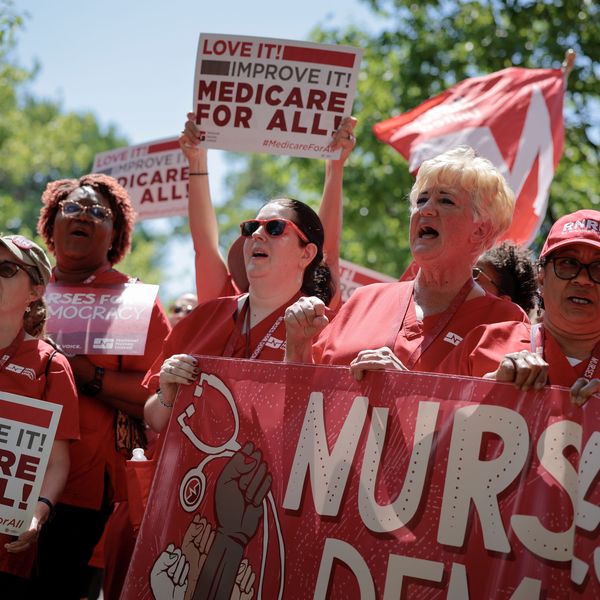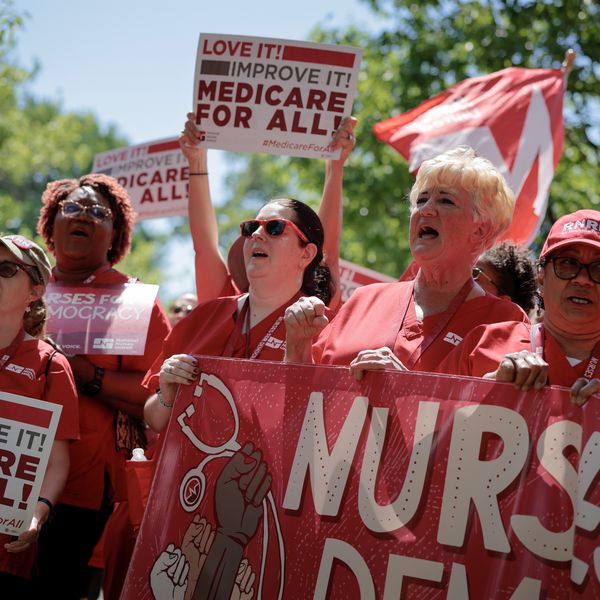Of course, it will pay for itself eventually, with lower administrative costs and savings on medications and provider fees.
Universal health care is getting closer to reality at the state level, in California. The Political Economy Research Institute (PERI) has analyzed a proposal for a statewide single-payer health care system that would reduce current costs by at least 8 percent. It would be funded in two ways: (1) a continuation of Medicare and MediCal; and (2) gross receipts and sales taxes, both at 2.3 percent, with exemptions for small businesses, low-income residents, and purchases of basic necessities. Unfortunately, California has postponed the plan, at least until January, 2018.
At the national level, Bernie Sanders' single-payer plan is forecasted to save $6 trillion over 10 years. It could be funded in part by the elimination of special treatment for capital gains, payroll taxes, and multi-million dollar estates. While anticipating inevitable resistance from monied interests, it can nevertheless be accurately demonstrated that three Americans--or, rather, groups of Americans--have received the most benefits from years of national productivity, and should provide most of the initial funding.
1. The Main Beneficiary of America's $31 Trillion Wealth Gain since the Recession
The 57 percent increase in U.S. wealth since the recession (from $54 to $85 trillion) was driven mainly by stocks and other financial investments. Most of this wealth is untaxed, deferred until a capital gain is realized. But it represents a return on U.S. productivity that has overwhelmingly benefited the nation's richest 10%--especially the highest tiers of that 10%: in 2016, the 1% gained nearly $4 trillion while everyone else lost wealth.
Taxing the nation's total financial wealth at 1 percent would bring in 2/3 of a trillion dollars. For the average member of the 1% with a net worth of $14,000,000, this is 1 percent of a portfolio that has grown at an 8 percent annual rate since the recession.
2. The Recipient of Tax Subsidies that Exceed the Entire Safety Net
The entire 2017 safety net is about $850 billion, compared to over $1.5 trillion for tax subsidies. A recent analysis found that:
- The Poorest 20% of U.S. Households Get up to $3,000 Each in Tax Subsidies
- The Richest 20% of U.S. Households Get at least $18,000 Each in Tax Subsidies
- The Richest 1% of U.S. Households Get over $120,000 Each in Tax Subsidies
The Congressional Budget Office itemizes the ten main tax expenditures, including mortgage interest, capital gains, employer health insurance, pension deductions, and state and local tax breaks. In addition, there's a mortgage interest deduction for second homes, which can even be a YACHT; up to a half-million dollars tax-free when a couple sells their home; over $10 million TAX-FREE when a couple's estate is passed on to heirs; deductions on rental properties for landlords, who are unlikely to be low-income people; the $127,200 limit on Social Security taxes, which benefits only the richest 10% of Americans; and higher education financial aid, especially from the prestigious universities that admit more students from families in the top 1% than the entire bottom 50%.
One good reason for wealthier Americans to support a better health care system: as the longevity of higher-earning Americans increases relative to low-income Americans, wealthy households benefit more and more from Medicare. A Brookings report estimates that lowest-quintile Americans born in 1960 will receive "only 78 percent of the lifetime Medicare benefits received by the top income quintile."
3. The Investor Who Pays ZERO Sales Tax on a Million-Dollar Sale
Illinois is mired in $15 billion of debt while the traders on LaSalle Street, who generate billions of dollars in profit from Chicago's technology and infrastructure and legal system, and who trade with a company that made a quadrillion (1,000 trillion) dollars in sales last year and kept a greater percentage of profit than any of the largest corporations in America, don't have to pay a penny of sales tax.
To help subsidize the traders, Illinois residents pay the 2nd-highest property taxes in the nation, and Chicago parents pay a 10 percent sales tax on school supplies for the kids.
A tiny financial transaction tax (FTT) of perhaps a tenth of a percent on the trading of financial securities could generate billions of dollars of revenue. Collecting many of the taxes in Illinois would be the Chicago Mercantile Exchange (CME), which handles a volume of trades worth many times the world economy, while profiting from transfer fees, contract fees, brokerage fees, Globex fees, clearing fees, and surcharges. Yet there are no sales taxes.
Will the Super-Rich Support American Health?
Not likely, one might think. But the financial speculation tax works in some of the most prosperous nations in the world; many tax subsidies are indefensible, even by the recipients; and available records on financial holdings make a 1 percent wealth tax feasible. We must do something to keep Americans alive.



